综合新闻
The 2015 International Workshop on Advanced Technologies in Power Electronics and Motor Drivers was held on Dec. 30, 2015 at Nanjing University of Aeronautics and Astronautics, Nanjing China. The workshop provided a forum for device scientists, circuit designers, and application engineers from the Power Electronics and Motor Driver Societies to share state-of-art technology, research findings, development experience and potential applications.
Power electronics and motor driver is an enabling technology with a variety of applications from industrial to transportation to commercial to appliances to energy efficiency and to handheld devices. Consequently, the amount of research work in related topics and the need for close collaborations among industry, research, and academia are growing in an unprecedented speed. The challenge in the coming years lies in developing new techniques at the lowest possible cost, size and weight for emerging or current applications.
The topics of 2015 International Workshop on Advanced Technologies in Power Electronics and Motor Drivers included:
Wireless Power Transfer
New type motor design
Grid-tied inverter
Energy management and control for micro-grid
Wide bandgap devices
Advanced control strategy for power conversion
Distributed Generation

The workshop schedule

The group photo of workshop representatives
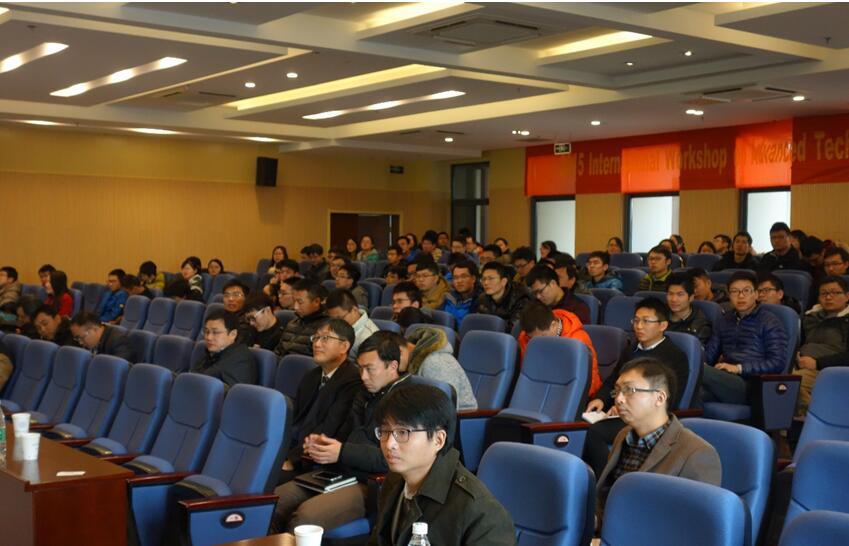
The workshop site photo
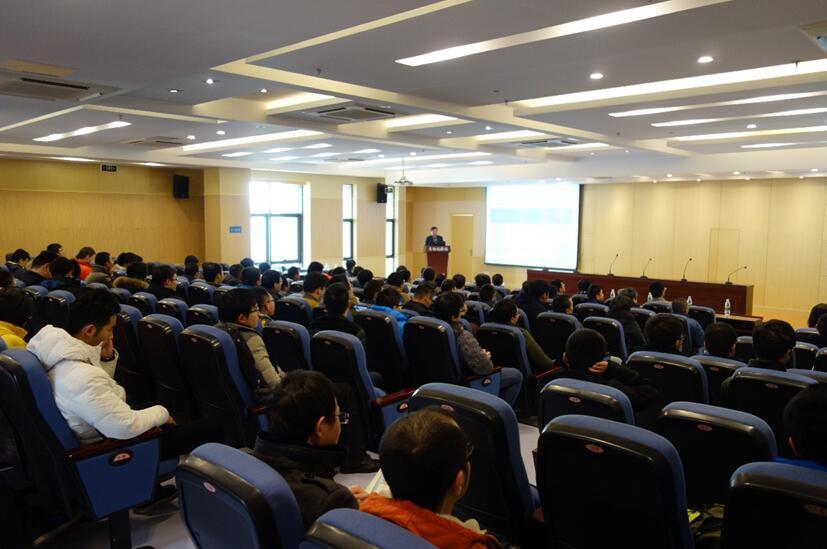
The workshop site photo
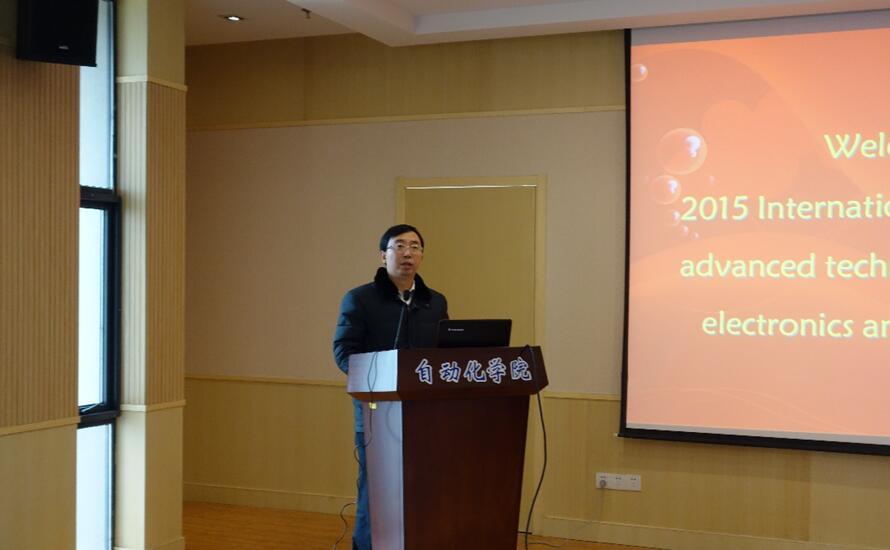
Welcome speech by Prof. Jiang Bin
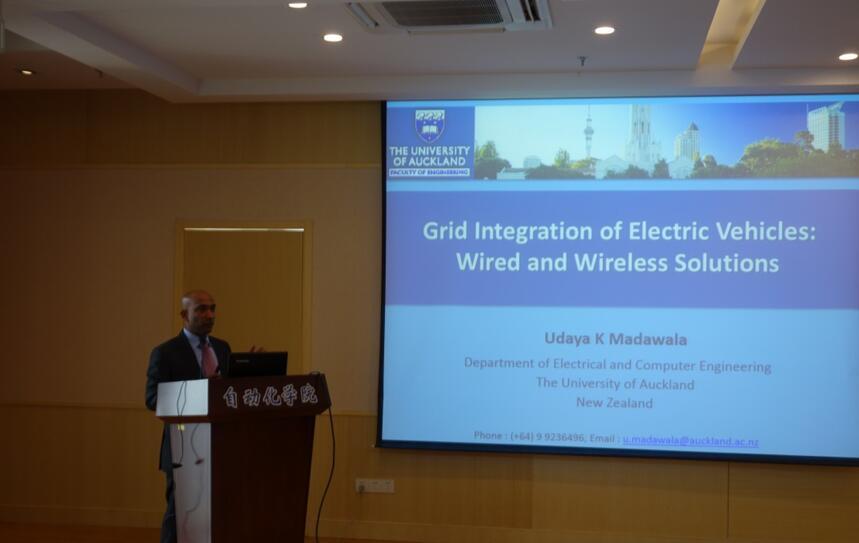
Presentation by Prof. Udaya K. Madawala

Presentation by Prof. Cheng Ming
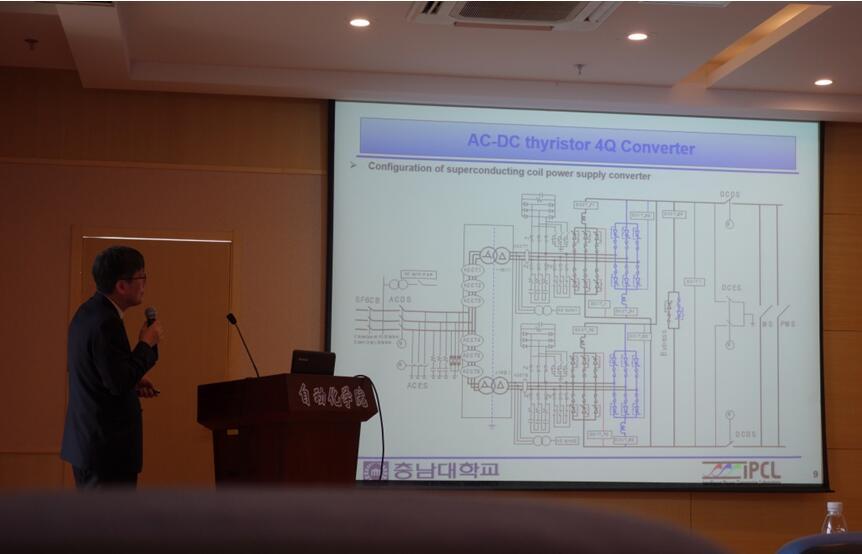
Presentation by Prof. Hanju Cha
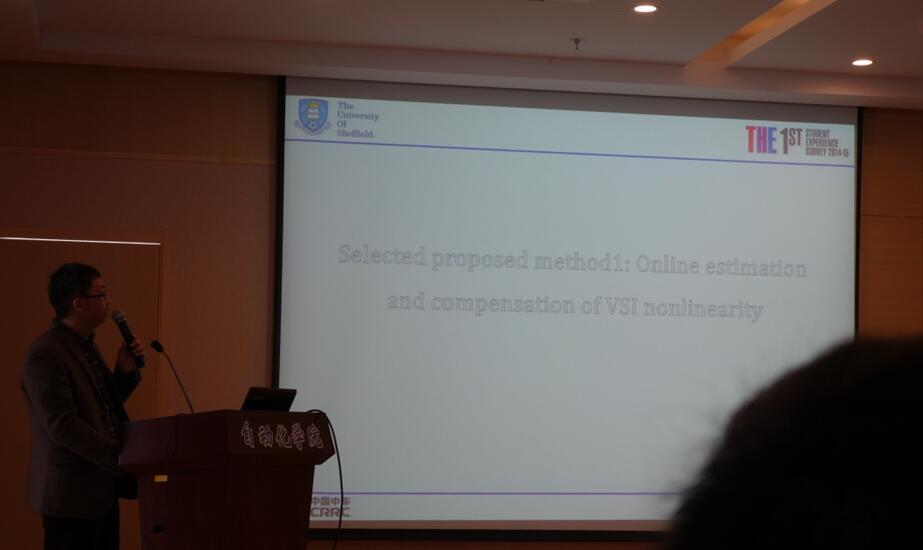
Presentation by Dr. LiuKan
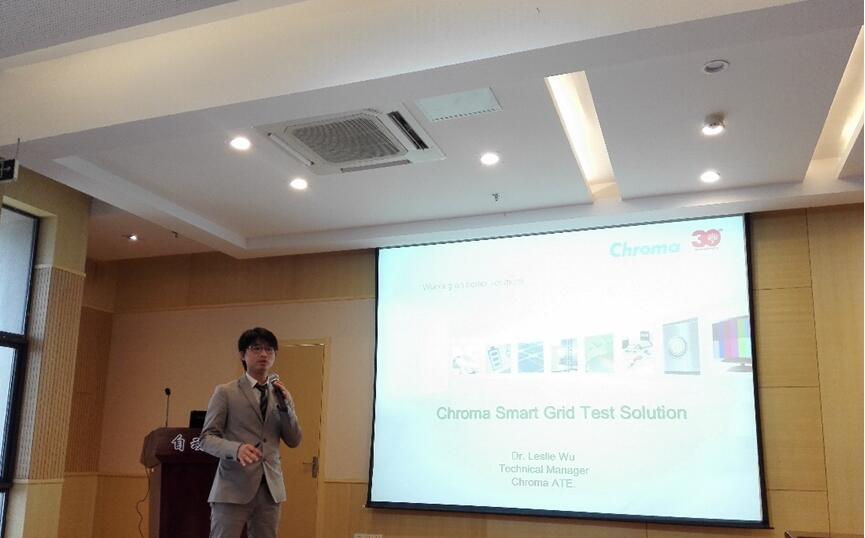
Presentation by Dr. Leslie Wu
Introduction of Report Abstract:
1. Grid Integration of Electric Vehicles: Wired and Wireless Solutions,Professor Udaya K. Madawala
Abstract:
Renewable Energy (RE) sources, energy storage systems and Electric Vehicles (EVs), together with effective energy management systems, can be considered as partial solutions to the global energy crisis. Indispensable to all these solutions is the power interface that facilitates either uni- or bi-directional power flow between the power grid and EVs/REs. An efficient, compact, cost effective and reliable power interface is, therefore, vital for grid integration of both EVs and REs. Consequently, grid integration has become one of the main focuses of current research in both industrial and academic communities. This seminar presents an overview of the speaker’s current research, which is followed by a discussion on the trends and latest advances in grid integration of EVs. Both wired and wireless solutions, proposed for grid integration of EVs, are presented while highlighting the challenges and future directions. The seminar focuses particularly on the Bi-directional Inductive Power Transfer (IPT) technology, developed at The University of Auckland for grid integration of EVs.
Biography:
Udaya K. Madawala (Senior Member IEEE) graduated with B. Sc. (Electrical Engineering) (Hons) from The University of Moratuwa, Sri Lanka in 1987 and received his PhD (Power Electronics), as a Commonwealth Doctoral Scholar, from The University of Auckland, New Zealand in 1993. At the completion of his PhD, he was employed by Fisher & Paykel Ltd, New Zealand, as a Research and Development Engineer to develop new technologies for motor drives in washing machines. In 1997, he joined the Department of Electrical and Computer Engineering at The University of Auckland as a Research Fellow, and currently works as a Full Professor, focusing on a number of energy related power electronics projects.
2. HILS based Verification of High Power Thyristor Converters for Superconducting Coils,Professor Hanju Cha
Abstract
HILS (Hardware-In-the-Loop Simulation) based verification of high power thyristor converters for superconducting coils is described. High power thyristor converters provide voltage and current to superconducting magnets for plasma control. They are composed of various high power AC-DC thyristor converters. Design and operation of converters are introduced, and the converters are applied to unit operation, 4 series connected operation and inductively coupled operation with 4 super conduction coils. To verify a feasibility of the high power thyristor converters, the experiment is performed by using real Zynq based controllers and RTDS (Real Time Digital simulator). Experimental results by using HILS(Hardware-In-the-Loop Simulation) are well matched to design of high power thyristor converters.
Biography
Hanju Cha received the B.S degree in electrical engineering from Seoul National University, Korea, the M.S degree from Pohang Institute of Science and Technology, Korea and the Ph.D degree from Texas A&M University, College station, TX in 1988, 1990 and 2004, all in electrical engineering. From 1990 to 2001, he was with LG industrial systems, Anyang, Korea, where he was engaged in the development of power electronics and adjustable speed drives. In 2005, he joined the Department of Electrical Engineering, Chungnam National University, Daejeon, Korea. He worked as a visiting professor in United Technology Research Center, Hartford CT, USA in 2009. His research interests are advanced /ac and ac/ac converter topologies, power quality and utility interface issues for distributed energy system and microgrids, battery modeling and identification, and HILS based high power system verifications.
3. Advances in Wind Power Generator Systems and Technology,Professor Ming Cheng
Abstract
With increasing concerns on energy crisis and environmental deterioration, the development and utilization of wind energy is attracting more and more attention. Hence, various new wind energy conversion technologies have been emerging in the past decade, aiming at reducing cost, enhancing efficiency and reliability. In this lecture, development status of wind power in the world and China will be briefly introduced. Then the state of the art of wind energy conversion systems (WECS) and technologies, with an emphasis on wind power generator, will be overviewed. Different types of common WECSs are classified according to their features and drive train types, and comparison of them are conducted on the basis of volume, weight, cost, efficiency, system reliability and fault ride through capability. Finally, the recent advances in innovative wind generator systems are elaborated, including the stator permanent magnet synchronous generators, the magnetic-geared generators, the brushless doubly fed induction generator, the dual power flow WECS with the electrical variable transmission (EVT) machine, etc., with a hope that such a study will be useful for the future R&D efforts in wind energy conversion.
Biography:
Prof. Ming Cheng(M'01�SM'02�F'15) received the B.Sc. and M.Sc. degrees from the Department of Electrical Engineering, Southeast University (formerly Nanjing Institute of Technology), Nanjing, China, in 1982 and 1987, respectively, and the Ph.D. degree from the Department of Electrical and Electronic Engineering, the University of Hong Kong, Hong Kong, in 2001, all in electrical engineering. Since 1987, he has been with Southeast University, where he is currently a Distinguished Professor in the School of Electrical Engineering, Director of the Research Center for Wind Power Generation, and Associate Director of Yancheng Research Institute of New Energy Vehicles. From 2002 to 2009, he served as the Dean of School of Electrical Engineering, Southeast University. As a Visiting Professor, he worked in the Wisconsin Electric Machines and Power Electronics Consortium (WEMPEC), the University of Wisconsin-Madison from January to April, 2011, and in the Department of Energy Technology, Aalborg University, Denmark from June to July, 2012, respectively. His research interests and experience include design and analysis of permanent magnet machines, variable speed motor drives for electric vehicles, wind power generator system and control, etc. Dr. Cheng has supervised over 80 graduate students, post docs, and scholars, of which two students won the National Excellent Doctoral Dissertation Nomination Award of China and four students won the Excellent Doctoral Dissertation Award of Jiangsu Province, China. He has published over 400 technical papers, 5 books and 4 book chapters, and holds over 50 issued Chinese invention patents in these areas. Dr. Cheng received many awards including "IET Premium Award in Electric Power Application" in 2009 and 2014 respectively, "GM Automotive Innovative Talent Award for China University" in 2008, "SAE Environmental Excellence in Transportation Award-Education, Training and Public Awareness" in 2006 and “Delta Scholar Award” in 2013. He was honored with the 1st Class of Natural Science Award by Ministry of Education, China in 2013, and the 2nd Class of Science and Technology Achievement Award by Jiangsu Province, China in 2005. He has served as Executive Committee Member of IEEE Nanjing Section since 2007 and is the founder and Chair of IEEE Nanjing Section IAS/PES Joint Chapter since 2008. He has served as chair and organizing committee member for many international conferences sponsored by IEEE IAS/PES/IES. He has served as the Expert Panel Member in the National Natural Science Foundation of China (NSFC) and in the National Key Basic Research Program (973 Program) of China, Editorial Board Member of theEnergy Conversion and Management, Sustainable Energy, the Transactions of China Electrotechnical Society, theProceedings of the Chinese Society for Electrical Engineering, etc.Dr. Cheng was elevated to IEEE Fellow in 2014 for contributions to the development and control of stator permanent magnet machines for vehicular propulsion and wind power generation. He is also a fellow of The Institution of Engineering and Technology (IET).
4. Parameteridentification of rare-earth PMSM drive system and controller design , Dr. Kan Liu
Abstract
The rare-earth permanent magnet synchronous machine (PMSM) is now widely employed in applications such as aerospace/aviation, servo control, wind power generation, high speed train and hybrid EV. In real applications, once the electrical parameters of PMSM with respect to different operation points or saturation levels can be identified, the design of current loop controllers, such as the dq-axis current regulators and MTPA/FW controllers, can be easily achieved while the mechanical parameter model of PMSM drive system, usually being used for the design of speed loop controllers, can also be consequently determined. Overall, the identification of electrical and mechanical parameters of PMSM drive system is still currently a difficulty in engineering and its application in control system design still needs more theoretical and practical investigations.
Biography
Kan Liu received the B.Eng. in automation from Hunan University, in 2005, and got scholarships from by the CSC and Siemens UK Wind Power Research Center in 2008 and 2011, respectively, for his study in the EMD group of the University of Sheffield. He received his Ph.D. degree in control theory and control engineering from Hunan University, in 2011, and was then awarded the Ph.D. degree in electronic and electrical engineering from the University of Sheffield, in 2013. He is the award winner of the outstanding Ph.D. thesis of Hunan University, in 2012 and has published more than 20 papers in journals and conferences. As the first author, he has published 8 IEEE journal papers, of which the total SCI impact points are more than 46. Besides, he is now a lead guest editor of Journal of Control Science and Engineering and invited as a reviewer for some world-famous journals such as IEEE Trans. on Ind. Electron., IEEE Trans. on Power Electron., IEEE Ind. Applicat., IEEE Trans. on Energ. Conv., IEEE Trans. on Applied Superconductivity, IEEE Trans. on Control Systems Technology. He is currently a research associate with the EMD group of the University of Sheffield and his research interest focuses on parameter estimation and condition monitoring of permanent-magnet synchronous machine drives, sensorless control, MTPA and FW controls, optimal PI regulator design, and compensation of VSI nonlinearity.
5. DC Power Flow Controller for Meshed HVDC Grids, Professor Wu Chen
Abstract
Power flow control ability of meshed high voltage direct current (HVDC) grids can be improved by inserting DC power flow controller into the grids. This presentation will focus on the review of existing DC power flow controller technology, and moreover, a novel interline DC power flow controller (IDCPFC) which has the benefit of less active switching devices, simpler control, little side effect on meshed grids, no external power source needed and wide application occasions is presented.
Biography
Wu Chen received the Ph.D. degrees in electrical engineering from the Nanjing University of Aeronautics and Astronautics (NUAA), Nanjing, China, in 2009.From 2009 to 2010, he was a Senior Research Assistant in the Department of Electronic Engineering, City University of Hong Kong, Hong Kong. In 2010�2011, he was a Postdoctoral Researcher in Future Electric Energy Delivery and Management Systems Center, North Carolina State University, Raleigh, USA. Since2011, he has been an Associate Professor with the School of Electrical Engineering, Southeast University, Nanjing, China. His main research interests include renewable energy utilization and power electronic application.
6. Hierarchical Power Management for Cooperative Microgrids, Dr. Yu Wang
Abstract
Although considerable advances have been made in single Microgrid (MG) systems, the problem of cooperation among MGs and the Microgrid has attracted considerable interest only recently. This work investigates a hierarchical power management approach to optimally manage power flows, storage and distribution in a smart power grid with a Microgrid and cooperative MGs. We first formulate the problem as a convex optimization problem and then decompose it into a two-tier formulation: the first-tier problem jointly considers user utility, transmission cost, and grid load variance, while the second-tier problem minimizes the power generation and transmission cost and exploits distributed storage in the MGs. We develop an effective online algorithm to solve the first-tier problem and prove its asymptotic optimality, as well as a distributed optimal algorithm for solving the second-tier problem. The proposed algorithms are evaluated with trace-driven simulations and are shown to outperform several existing schemes with considerable gains.
Biography
Yu Wang received the B.Sc. and M.Sc. degrees from the Department of Instrumental Science and Technology in Southeast University, Nanjing, China, in 2008 and 2011 respectively, and the Ph.D. degree from the Department of Electrical and Computer Engineering in Auburn University, Auburn, AL, U.S.A, in 2015. Since Sep. 2015, he has joined the Department of Electrical Engineering as a faculty member in Nanjing University of Aeronautics and Astronautics (NUAA), Nanjing, China. His research interests include energy distribution,power flow dispatching, optimization, and forecasting in the control and management of smart grids and micro-grids.
Dr. Wang has served as TPC member in IEEE ICCCN’15 and IEEE INFOCOM Workshop’15, and reviewers in several IEEE transactions and conferences, including TII, TETC, TVT, and IoT-J. He was the SessionChair of WN-1 in IEEE GLOBECOM’13.
7. Aircraft Power and Propulsion Systems-Research Challenges and Opportunities for Electrical Systems, Professor HaoZhenyang
Abstract:
NASA has compiled a set of research goals for five year periods starting 2015, 2020 and 2025 for three classes of future subsonic aircraft, N+1 (2015), N+2 (2020) and N+3 (2025). And, the current More Electric Aircraft (MEA) design concepts are advancing to allow the near term, N+1 goals of reducing 32 dB of noise emissions, 60 % of the landing and take-off (LTO) NOx emissions. So, what should we do tomeet the nextN+2 and N+3? Thepresentantion then goes on to look at concepts employed in order to facilitate the removal of pneumatic and hydraulic systems, protection systems for the new more electric architecture and concludes by highlighting the technological and electrical systems integration challenges faced in the development of aircraft architectures to meet the N+2 goals by using the more/all electric aircraft design philosophy.
Biography:
HaoZhenyang was born in 1981. He received the B.S. degrees from Nanjing Normal University in 2004, in Electrical Engineering, and Ph.D. degree from Nanjing University of Aeronautics and Astronautics in 2010, in Power Electronics and Motion Drive.Dr. Hao has been engaged in the teaching and research in the filed of Motion Drive from 2010 in Nanjing University of Aeronautics and Astronautics (NUAA). He has been an associate professor since 2013 in NUAA.His current research interests include permanent mengnet motor design, direct torque control and fault tolerant control techniques. He has published over 20 technical papers. Dr. Hao was awarded the scientific and technology achievement in aeronautics for the project of permanent magnet fault tolerant motor drive system in 2011. He has been PI or Co-PI for over 10 reseach projects since 2010.
8. Chroma Smart Grid Test Solution, Dr. Leslie Wu
Abstract:
This presentation is about in the last few years, how Chroma provides the test solutions in the smart grid system. The content will focus on the essential techniques in the battery power simulator, solar array simulator, and grid simulator.
Biography:
Leslie Wu was born in Taipei, Taiwan, in 1984. He received the B.S. and Ph.D. degree in electronic engineering from National Taiwan University of Science and Technology, Taipei, Taiwan, in 2006 and 2012, respectively. From Mar. 2010 to Mar. 2011, he was conducted research about solar system and grid-tie inverter at Virginia Tech, USA, while supported by scholarship from National Science Council. Since 2012, he has been with Chroma ATE., where he is currently in the advanced technology research center as a technical manager. His research interests include switching mode power supplies, smart grid system, LED drivers, and control applications.
9. Very High Frequency DC/DC Converters, Professor Zhang zhiliang
Abstract:
This talk is about Very High Frequency (VHF, 30 MHz~300 MHz) converters including the topology, control and design. The key research points include the topologies, FET drivers, and optimal design. Considering the parasitic of the circuit, the decoupling design method is proposed based on the VHF SEPIC topology. The commercial gate drivers for the GaN transistors focus on high reliability to the precise gate drive voltage against the parasitic components. To reduce the high reverse conduction loss of the GaN power transistors due to the reverse conduction mechanism before ZVS turn-on, in the meanwhile, ensure the high stability and reliability, a new driving scheme with the mid-level voltage is proposed. Resonant gate drivers (RGDs) for Si MOSFETs are also introduced for Multi-MHz resonant converters. The SR technique is applied to an isolated class-Φ2 resonant converter and proposes a self-driven level-shifted RGD for the SR FET. The proposed RGD can reduce the average on-state resistance and the associated conduction loss of the MOSFET
Biography:
Zhiliang Zhang received the B.Sc. and M.Sc. degrees in Electrical Engineering from Nanjing University of Aeronautics and Astronautics (NUAA), Nanjing, P. R. China in 2002 and 2005, and the Ph.D. degree from the Department of Electrical and Computer Engineering, Queen’s University at Kingston, Canada, in 2009. In June, 2009, he joined NUAA and currently, he is a Professor with Aero-Power Sci-Tech Center. His research interests include high-frequency power converters and power management for EVs. He serves as secretary of PELS Technical Committee on Power & Control Core Technologies since 2013.